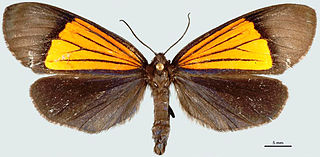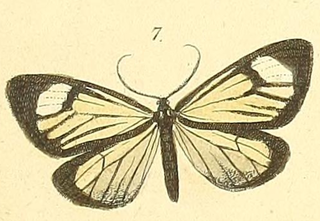
Notodontidae is a family of moths with approximately 3,800 known species. The family was described by James Francis Stephens in 1829. Moths of this family are found in all parts of the world, but they are most concentrated in tropical areas, especially in the New World.

The coxcomb prominent is a moth of the family Notodontidae. It is a common species throughout the Palearctic realm from Ireland to Japan. It was first described by Carl Linnaeus in his 1758 10th edition of Systema Naturae.

Oenosandra is a monotypic moth genus in the family Oenosandridae. Its only species, Oenosandra boisduvalii, or Boisduval's autumn moth, is found in the southern half of Australia, including Tasmania. Both the genus and species were first described by Edward Newman in 1856.

Discophlebia catocalina, the yellow-tailed stub moth is an Australian moth species found in the south-eastern quartile of Australia. It is classified within the Oenosandridae moth family in the Noctuoidea Superfamily, the largest superfamily of the Order Lepidoptera. It is visually recognised by its characteristic pointed yellow tail and is a medium-sized moth species with a wingspan range of 40mm-60mm depending on gender. Discophlebia Catocalina have evolved to feed on various species of eucalypt.

Ephialtias bryce is a moth of the family Notodontidae. It is endemic to the basin of the Rio Tapajos in Brazil.

Erbessa mimica is a moth of the family Notodontidae first described by Hering in 1925. It is found in Bolivia. The life expectancy of the moth is around 60 to 90 days.

Scea subcyanea is a moth of the family Notodontidae. It is found in Peru.

The Erebidae are a family of moths in the superfamily Noctuoidea. The family is among the largest families of moths by species count and contains a wide variety of well-known macromoth groups. The family includes the underwings (Catocala); litter moths (Herminiinae); tiger, lichen, and wasp moths (Arctiinae); tussock moths (Lymantriinae), including the arctic woolly bear moth ; piercing moths ; micronoctuoid moths (Micronoctuini); snout moths (Hypeninae); and zales, though many of these common names can also refer to moths outside the Erebidae. Some of the erebid moths are called owlets.
Scotura flavicapilla is a moth of the family Notodontidae. It is found in French Guiana, Suriname, Guyana and Brazil.
Scotura fulviceps is a moth of the family Notodontidae. It is found in Brazil, Guyana and Peru.
Oricia truncata is a moth of the family Notodontidae. It is found from Mexico south to Panama.
Erbessa decolorata is a moth of the family Notodontidae first described by Hering in 1925. It is found in Brazil, Colombia and French Guiana.
Erbessa projecta is a moth of the family Notodontidae first described by William Warren in 1909. It is found in Brazil.
Xenorma australis is a moth of the family Notodontidae. It is found in Brazil.
Phaeochlaena solilucis is a moth of the family Notodontidae. It is found in Brazil, Bolivia, Ecuador and Colombia.
Polypoetes prodromus is a moth of the family Notodontidae. It is found in Bolivia.
Polypoetes luteivena is a moth of the family Notodontidae. It is found in Colombia and Venezuela.
Brachyglene crocearia is a moth of the family Notodontidae first described by William Schaus in 1912. It is found in Costa Rica, Honduras and Guatemala.

Monocreagra pheloides is a moth of the family Notodontidae first described by Cajetan and Rudolf Felder in 1874. It is found in Colombia, Ecuador and Peru.
Nystaleinae is a subfamily of the moth family Notodontidae. The subfamily was described by William Trowbridge Merrifield Forbes in 1948.









